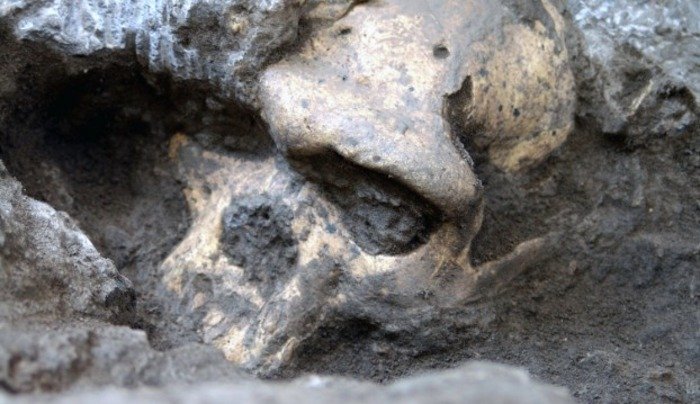Fossil skull unearthed in Georgia. Credit: Georgian National Museum
TBILISI, Georgia, Oct. 17 (UPI) -- The discovery of a 1.8-million-year-old human skull in Europe is igniting debate on the origins of distinct species of ancient human relatives, scientists say.
Unearthed in the eastern European nation of Georgia, the skull has generated controversy over the fossil's proper place in our species' poorly understood family tree, they said.
"This is most complete early Homo skull ever found in the world," lead study author David Lordkipanidze of the Georgian National Museum in Tbilisi said.
The find, simply dubbed Skull 5, is the fifth example of a hominid -- a primate that walked upright -- from this time period found at the site in Dmanisi, Georgia.
Lordkipanidze and his colleagues have sparked debate by proposing these individuals are members of a single evolving Homo erectus species, examples of which have been found in Africa and Asia.
The fossil record of what have previously been considered different Homo species from the time period -- including Homo ergaster, Homo rudolfensis and Homo habilis -- could be variations on a single species, Homo erectus, they said.
That would contradict the current understanding of how early human relatives should be classified, some paleontologists said.
"The specimen is wonderful and an important contribution to the hominin record in a temporal period where there are woefully too few fossils," Lee Berger, paleoanthropologist at the University of the Witwatersrand in Johannesburg, said in an email to CNN.
The suggestion that these fossils prove an evolving lineage of Homo erectus in Asia and Africa, Berger said, is "taking the available evidence too far."
Other scientists were even more adamant.
"No way this extraordinarily important specimen is Homo erectus," Ian Tattersall, curator emeritus at the American Museum of Natural History's anthropology division, said in an email.
The museum's Hall of Human Origins contains examples of human evolutionary history, with distinct Homo species reflected in major fossil finds such as Homo ergaster and Homo erectus.
While the the Dmanisi discovery may find a place there too, Tattersall said, it's probably not going to result in relabeling other species.
"Right now I certainly wouldn't change the Hall -- except to add the specimen, which really is significant," he said.















